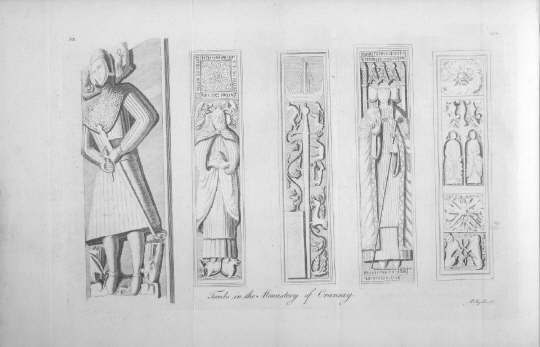Oronsay Priory on:
[Wikipedia]
[Google]
[Amazon]
Oronsay Priory was a


monastery
A monastery is a building or complex of buildings comprising the domestic quarters and workplaces of monastics, monks or nuns, whether living in communities or alone (hermits). A monastery generally includes a place reserved for prayer which ...
of canons regular
Canons regular are priests who live in community under a rule ( and canon in greek) and are generally organised into religious orders, differing from both secular canons and other forms of religious life, such as clerics regular, designated by a ...
on the island of Oronsay
This is a list of islands called Oronsay (Scottish Gaelic: '), which provides an index for islands in Scotland with this and similar names. It is one of the more common names for Scottish islands. The names come from ''Örfirisey'' which transla ...
, Inner Hebrides, Argyll
Argyll (; archaically Argyle, in modern Gaelic, ), sometimes called Argyllshire, is a historic county and registration county of western Scotland.
Argyll is of ancient origin, and corresponds to most of the part of the ancient kingdom of ...
, off the coast of Scotland. It was in existence by 1353 under the patronage of John of Islay, Lord of the Isles
:''This article refers to John I, Lord of the Isles; for John II, see John of Islay, Earl of Ross''
John of Islay (or John MacDonald) ( gd, Eòin Mac Dòmhnuill or gd, Iain mac Aonghais Mac Dhòmhnuill) (died 1386) was the Lord of the Isles (1 ...
. It was dedicated to St. Columba
Columba or Colmcille; gd, Calum Cille; gv, Colum Keeilley; non, Kolban or at least partly reinterpreted as (7 December 521 – 9 June 597 AD) was an Irish abbot and missionary evangelist credited with spreading Christianity in what is toda ...
, and perhaps was a continuation or a re-activation of an older foundation. Very little is known about it because of the absence of records and its remoteness from the Scottish Lowlands
The Lowlands ( sco, Lallans or ; gd, a' Ghalldachd, , place of the foreigners, ) is a cultural and historical region of Scotland. Culturally, the Lowlands and the Highlands diverged from the Late Middle Ages into the modern period, when Lowl ...
, but on occasions some of the Priors of Oronsay come into the records.
The Priory
The priory continued in operation until at least 1560, the year of theScottish Reformation
The Scottish Reformation was the process by which Kingdom of Scotland, Scotland broke with the Pope, Papacy and developed a predominantly Calvinist national Church of Scotland, Kirk (church), which was strongly Presbyterianism, Presbyterian in ...
, with the last known prior, Robert Lamont, having been elected in 1555. The lands and property of the priory were given ''in commendam
In canon law, commendam (or ''in commendam'') was a form of transferring an ecclesiastical benefice ''in trust'' to the ''custody'' of a patron. The phrase ''in commendam'' was originally applied to the provisional occupation of an ecclesiastical ...
'' to Maol Choluim MacDubhthaich in 1561. They were later given to the Bishop of the Isles
The Bishop of the Isles or Bishop of Sodor was the ecclesiastical head of the Diocese of the Isles (or Sodor), one of Scotland's thirteen medieval bishoprics. The bishopric, encompassing both the Hebrides and Mann, probably traces its origins as ...
by King James VI of Scotland
James VI and I (James Charles Stuart; 19 June 1566 – 27 March 1625) was King of Scotland as James VI from 24 July 1567 and King of England and Ireland as James I from the union of the Scottish and English crowns on 24 March 1603 until hi ...
after his ascendancy to the throne in 1583. Restoration work and excavation and recording were carried out in 1883 by the architect William de B M Galloway and again in 1927 by the Ministry of Works and are visible today, together with the High Cross, as a scheduled ancient monument
In the United Kingdom, a scheduled monument is a nationally important archaeological site or historic building, given protection against unauthorised change.
The various pieces of legislation that legally protect heritage assets from damage and d ...
.
Additional burial enclosures were added as late as the 19th century.
High Cross
The High Cross stands about four metres east of the ruins of the monastery church and rises from a four-tiered foundation. From the inscription it can be seen that the cross recalls the death of the prior Colin, who presided over the Oronsay monastery and probably dates from the year 1510, Colin's dying year. On the westward side of the cross are scenes of the crucifixion of Jesus and on the east side are foliage motifs.

See also
*John of Islay, Lord of the Isles
:''This article refers to John I, Lord of the Isles; for John II, see John of Islay, Earl of Ross''
John of Islay (or John MacDonald) ( gd, Eòin Mac Dòmhnuill or gd, Iain mac Aonghais Mac Dhòmhnuill) (died 1386) was the Lord of the Isles (1 ...
* Prior of Oronsay
* List of monastic houses in Scotland
List of monastic houses in Scotland is a catalogue of the abbeys, priories, friaries and other monastic religious houses of Scotland.
In this article alien houses are included, as are smaller establishments such as cells and notable monastic ...
Bibliography
* Cowan, Ian B. & Easson, David E., ''Medieval Religious Houses: Scotland '', Second Edition, (London, 1976), p. 76 * Watt, D.E.R. & Shead, N.F. (eds.), ''The Heads of Religious Houses in Scotland from the 12th to the 16th Centuries'', The Scottish Records Society, New Series, Volume 24, (Edinburgh, 2001), pp. 165–7References
External links
{{commons inline Argyll and Bute 1353 establishments in Scotland Augustinian monasteries in Scotland Christian monasteries established in the 14th century Scheduled Ancient Monuments in Argyll and Bute Former Christian monasteries in Scotland